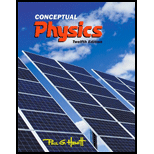
Concept explainers
Poke a hole in a piece of cardboard and hold the cardboard horizontally in the sunlight (as in Figure 1.6). Note the image of the Sun that is cast below. To convince yourself that the round spot of light is an image of the round Sun, try using holes of different shapes. A square or triangular hole will still cast a round image when the distance to the image is large compared with the size of the hole. When the Sun's rays and the image surface are perpendicular, the image is a circle; when the Sun's rays make an angle with the image surface, the image is a "stretched-out" circle, an ellipse. Let the solar image fall upon a coin, say a dime. Position the cardboard so the image just covers the coin. This is a convenient way to measure the diameter of the image-the same as the diameter of the easy-to-measure coin. Then measure the distance between the cardboard and the coin. Your ratio of image size to image distance should be about .
Want to see the full answer?
Check out a sample textbook solution
Chapter 1 Solutions
Conceptual Physics (12th Edition)
- Imagine light striking the edge of a prism. Draw the path of the light through the prism using the model of the marchers.arrow_forwardA ray of light is incident on the surface of a crown glass plate at an angle of 35° with the normal. Determine the angle between the refracted ray and the reflected ray. (refer to the figure on the right)arrow_forwardAll spotlights are place at 15 meters from the stage. You want to produce a circle of light of 2meters diameter with the SPOTLIGHT#1 on the Player #1, a rectangle of light of 2m by 1m with the SPOTLIGHT #2 on the Player #2 and a circle of light of 1meter diameter with the SPOTLIGHT#3 on the Player #3 Calculate the BEAM ANGLE of the SPOTLIGHT#1 and SPOTLIGHT#3arrow_forward
- Please refer to part (a) of Figure 1. Here, alpha (the angle at the top of the triangular prism) is 66.3 degrees. What is theta (the angle below the horizontal that the ray makes emerging from the prism on the right)? 46.0 degrees 32.2 degrees 59.8 degrees 82.8 degreesarrow_forwardThe diagram below shows the path of a ray of light entering a prism medium.What is the name of the line segment N-N1 and M-M1?arrow_forwardThe image with the diagram serves as a reference for the second image with the actual question. Please answer the question on the image without the diagram.arrow_forward
- In figure 5, draw the path that light follows until it reaches the bottom face of the prism.arrow_forwardThe Image of the Lshaped object in the picture below is formed by a. - The image is and concave mirror, reat; inverted B divergent lens; virtual; upright divergent lens; real; inverted convergent lens; real; upright O convergent lens; real; invertedarrow_forwardA student in a physics classroom measured the distance from a convex lens (focal length of 4cm) to the object as 20 centimeters. The distance from the lens to the image projected on a screen is 5 centimeters from the lens. What is the magnification of the image?arrow_forward
- The focal length of a convex mirror is negative. What does this tell you about the size of the magnification of the image? The sign? For a concave mirror, an object is place three focal lengths from the mirror. Where is the image? What is its orientation? Does a flat mirror produce a real or virtual image? What is its magnification?arrow_forwardsketch a diagram and label the object, concave and convex lenses, focal points, and all images.arrow_forwardPlease refer to part (a) of Figure 1 included. Here, alpha (the angle at the top of the triangular prism) is 30.6 degrees. What is theta? (the angle below the horizontal that the ray makes emerging from the prism on the right) 21.2 degrees 26.1 degrees 16.3 degrees 8.2 degreesarrow_forward
 Foundations of Astronomy (MindTap Course List)PhysicsISBN:9781337399920Author:Michael A. Seeds, Dana BackmanPublisher:Cengage Learning
Foundations of Astronomy (MindTap Course List)PhysicsISBN:9781337399920Author:Michael A. Seeds, Dana BackmanPublisher:Cengage Learning Stars and Galaxies (MindTap Course List)PhysicsISBN:9781337399944Author:Michael A. SeedsPublisher:Cengage Learning
Stars and Galaxies (MindTap Course List)PhysicsISBN:9781337399944Author:Michael A. SeedsPublisher:Cengage Learning


